MORE THAN PERFORMANCE:
CORVETTE ZR1’S CHASSIS AND SUSPENSION DELIVER A
CONFIDENT,
COMFORTABLE DRIVING EXPERIENCE
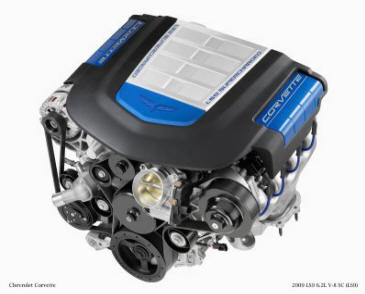 Its
supercharged engine twists out more than 600
horsepower and nearly 600 lb.-ft. of torque. Its
racing-inspired dual-disc clutch channels that power
to a set of massive, 20-inch by 12-inch rear wheels,
helping push the ZR1 to more than 200 mph (320
km/h). It also delivers more than 1g of lateral
acceleration and stops with exceptional immediacy.
Its
supercharged engine twists out more than 600
horsepower and nearly 600 lb.-ft. of torque. Its
racing-inspired dual-disc clutch channels that power
to a set of massive, 20-inch by 12-inch rear wheels,
helping push the ZR1 to more than 200 mph (320
km/h). It also delivers more than 1g of lateral
acceleration and stops with exceptional immediacy.
Yet for
all its astounding performance attributes, the 2009
Corvette ZR1 has a refined driving experience that
makes it a daily-driveable supercar.
“The
ZR1 is a car anyone can drive confidently and
comfortably,” said Tom Wallace, vehicle line
executive. “From the very beginning, refinement,
balance and compliance were targets that were as
important as the car’s maximum performance.”
More
than simply scaling wheel, tire and brake sizes to
match the powertrain’s output, the ZR1’s engineers
harmonized the chassis and suspension components to
deliver a driving experience that combines an
exceptional ride quality with racing-inspired
performance. Enabling elements include standard
Magnetic Selective Ride Control and new, Michelin
Pilot Sport 2 tires that were developed specifically
for the car.
“The
ZR1’s handling performance builds on the Z06, but
has ride compliance more like the base coupe,” said
Tadge Juechter, Corvette chief engineer. “Every
element from the stabilizer-bar diameters to the
composition of the tires was carefully matched to
deliver a balanced driving experience – it’s a
supercar that doesn’t sacrifice ride quality for
performance.”
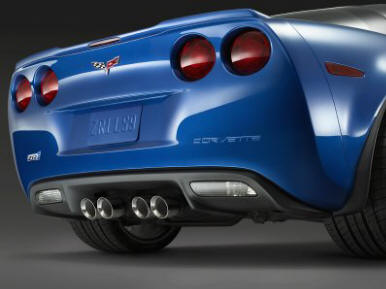 Stopping
power is derived from a carbon-ceramic-based brake
system that is lightweight, heat resistant and wear
resistant. While delivering braking performance
similar to a racecar, it helps reduce the unsprung
mass that the ZR1 would have accrued through the use
of similarly sized cast iron brake rotors.
Stopping
power is derived from a carbon-ceramic-based brake
system that is lightweight, heat resistant and wear
resistant. While delivering braking performance
similar to a racecar, it helps reduce the unsprung
mass that the ZR1 would have accrued through the use
of similarly sized cast iron brake rotors.
“It
wasn’t enough to achieve the braking requirements
commensurate with the car’s performance – we needed
to find a solution that minimized the impact on the
car’s balanced feel,” said Juechter. “A larger brake
package generally means more weight, but the
carbon-ceramic rotors deliver excellent performance
while also minimizing unsprung weight.”
Lightweight structure
The ZR1
has an aluminum structure for optimum stiffness and
low mass. It is the same structure used on the Z06,
but with specific body panels and drivetrain
components mounted to it.
The
chassis is constructed with perimeter rails made of
strong, single-piece hydroformed aluminum members
featuring cast suspension nodes. Other castings,
stampings and extrusions are combined into the
structure with state-of-the-art manufacturing
technologies. Advanced structural composites
featuring carbon-fiber are bonded to the aluminum
structure. The passenger compartment floors, for
example, combine carbon-fiber skins with an
ultra-lightweight balsa wood core.
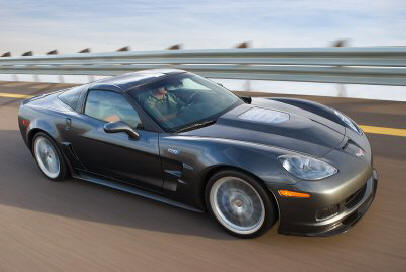
Like
the Z06, the ZR1 has a magnesium cradle that serves
as the attachment point for the engine and some
front suspension components, with the new LS9 engine
sitting slightly lower in the chassis than the Z06’s
LS7 engine. Magnesium is lighter than aluminum yet
incredibly strong. The magnesium cradle helps
improve the front-to-rear weight distribution, as do
the carbon-fiber front fenders, hood and
wheelhouses.
To
optimize the weight balance, the battery is located
in the rear cargo area, behind the right rear wheel.
Suspension tuning and Magnetic Selective Ride
Control
The ZR1
retains the 105.7-inch (2,686-mm) wheelbase of other
Corvette models, as well as the short-long arm
suspension and transverse spring design, but it
rides on all-new, wider wheels and tires, stops with
carbon-ceramic brakes and features specific spring
and stabilizer bar rates – the largest-diameter
stabilizer bars available on a Corvette. Also, the
axle half-shafts are angled more horizontally to
align with the different geometry created by the
ZR1’s larger-diameter and wider rear wheels.
Magnetic Selective Ride Control (MSRC) is standard
and tuned specifically for the ZR1. It is a
real-time damping system that replaces conventional
mechanical-valve shocks with electronically
controlled shocks filled with a synthetic fluid
containing minute iron particles. Under the presence
of magnetic charge, the iron particles align to
provide damping resistance almost instantly.
MSRC
“reads” the road in 1-milisecond intervals (a
thousand times per second), making it the world’s
fastest-reacting damping system. Its ability to
deliver a compliant ride with nearly instantaneous
damping adjustments enabled engineers to develop a
surprisingly supple ride quality in a supercar that
still delivers cornering grip of more than 1g.
“The
damping control of MSRC allowed for front and rear
springs that have a slightly lower rate than the
Z06, which enhances the car’s ride quality,” said
Juechter.
From a
high-performance perspective, Magnetic Selective
Ride Control helps the rear axle remain planted
during launch for smooth, hop-free acceleration. It
also helps suppress axle movement when cornering on
broken or uneven pavement.
With
cornering capability greater than the Z06, the ZR1’s
powertrain was upgraded with a higher-capacity oil
pump and larger-capacity oil reservoir. This ensures
optimal oil pressure during the highest-load driving
maneuvers.
Carbon-ceramic brakes
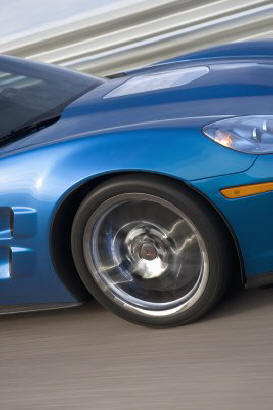 The
ZR1 comes standard with carbon-ceramic brake rotors
and large-capacity calipers at all for corners. The
exotic carbon-ceramic rotors are made of a
carbon-fiber-reinforced ceramic silicon carbide
material, which offers low mass and exceptional
resistance to wear and heat.
The
ZR1 comes standard with carbon-ceramic brake rotors
and large-capacity calipers at all for corners. The
exotic carbon-ceramic rotors are made of a
carbon-fiber-reinforced ceramic silicon carbide
material, which offers low mass and exceptional
resistance to wear and heat.
The
vented and cross-drilled rotors on the ZR1 measure
15.5 inches (394 mm) in diameter in the front and 15
inches (380 mm) in diameter in the rear – making
them among the largest carbon-ceramic rotors
available on any production vehicle. And while large
in size, they are low in mass, saving approximately
11 pounds (5 kg) per corner over comparably sized
cast iron rotors.
The
rotors are acted upon by six-piston front calipers
and four-piston rear calipers, each painted a
ZR1-exclusive blue. The front pads are equivalent in
size to the largest on any production car with a
single-pad design, measuring 148 sq. cm. in surface
area – double that of the Corvette Z06’s 70-sq.-cm.
front pads.
Braking
performance of the ZR1 is nothing short of
phenomenal, with the carbon-ceramic rotors and large
calipers combining to provide exceptionally short,
fade-free stopping during high-performance driving.
The composition and durability of the non-metallic
carbon-ceramic materials mean the rotors should
never show any corrosion or require replacement for
the life of the vehicle, when used in normal
driving.
A new,
Bosch brake-apply system is standard, and includes
the brake master cylinder, booster and ABS control
module. It is tuned specifically for the ZR1 and is
not shared with other Corvette models. The system
works with Magnetic Selective Ride Control to
deliver a very competent and intuitive active
handling system – complete with a Competitive
Driving mode.
Michelin Pilot Sport 2 tires
The ZR1
rides on Michelin Pilot Sport 2 (PS2) tires,
measuring P285/30ZR19 in front and P335/25ZR20 in
the rear. And while the PS2 tire is familiar with
enthusiasts, those on the ZR1 were engineered
specifically for the car.
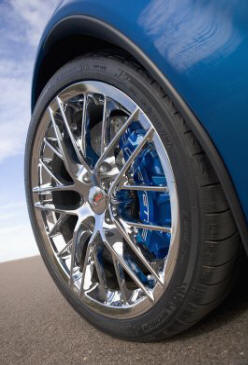 “We
didn’t merely specify a set of off-the-shelf PS2s
for the ZR1,” said Juechter. “Michelin’s engineers
worked with GM to develop tires for the car that
took into account factors such as the ZR1’s
performance goals, expected horsepower, curb weight,
weight distribution, aerodynamic downforce, top
speed and more. The construction of these tires is
unique to the ZR1.”
“We
didn’t merely specify a set of off-the-shelf PS2s
for the ZR1,” said Juechter. “Michelin’s engineers
worked with GM to develop tires for the car that
took into account factors such as the ZR1’s
performance goals, expected horsepower, curb weight,
weight distribution, aerodynamic downforce, top
speed and more. The construction of these tires is
unique to the ZR1.”
To save
weight, there is no spare tire in the ZR1; the PS2
tires feature Michelin’s ZP technology and can be
driven for a short distance with zero pressure until
servicing can be attained.
Racing-inspired wheels
The ZR1
rides on exclusive 20-spoke alloy rims that measure
19 inches by 10 inches in the front and 20 inches by
12 inches in the rear, making them the largest ever
offered on a Corvette. Their design was inspired by
the multi-spoke racing wheels used on Corvette C6R
racecars, which enhance the strength of the wheel at
the rim. A bright, Sterling Silver paint finish is
standard and a chrome version is optional.
The
wheels, while slightly larger in mass than the
smaller wheels of the Z06, were developed to be as
lightweight as possible, minimizing the ZR1’s
unsprung mass.
Next - -
>